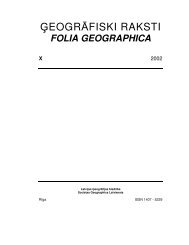Section âGroundwater in Sedimentary Basinsâ - Latvijas UniversitÄte
Section âGroundwater in Sedimentary Basinsâ - Latvijas UniversitÄte
Section âGroundwater in Sedimentary Basinsâ - Latvijas UniversitÄte
You also want an ePaper? Increase the reach of your titles
YUMPU automatically turns print PDFs into web optimized ePapers that Google loves.
source pollution <strong>in</strong> agriculture is a common problem <strong>in</strong> the region and is solved <strong>in</strong>a different way <strong>in</strong> each country. All of the countries <strong>in</strong> the region, except Russia,are subject to European Union (EU) groundwater directive restrictions. EuropeanEnvironmental Agency (EEA) EUROWATERNET data bases are available for abetter understand<strong>in</strong>g of the quality of groundwater and its contam<strong>in</strong>ation <strong>in</strong> theregion.In the research, the present situation is analyzed and advice and conclusionshave been provided for future groundwater quality scenarios for the Baltic Searegion. A monitor<strong>in</strong>g system has been established <strong>in</strong> all Baltic region countries <strong>in</strong>accordance with EU directives to determ<strong>in</strong>e and forecast groundwater quality.This study is supported by the European Social Fund project “Establishment of<strong>in</strong>terdiscipl<strong>in</strong>ary scientists group and modell<strong>in</strong>g system for groundwater research”.No. 2009/0212/1DP/1.1.1.2.0/09/APIA/VIAA/060.THE VISUALISATION OF GROUNDWATER CHEMICALCOMPOSITION USING THE RGB SCALE.AN EXAMPLE FROM THE D12 AQUIFER, LATVIAAndis KALVĀNSUniversity of Latvia, Faculty of Geography and Earth Sciences, e-mail: andis.kalvans@lu.lvGroundwater composition is traditionally visualised us<strong>in</strong>g the Piper diagramwhere the relative concentration of all major <strong>in</strong>organic components are plotted <strong>in</strong>ternary diagrams. This is a convenient approach to identify different water typesor, for example, to study the evolution of water composition along the flow l<strong>in</strong>es.However, it is not easy to exam<strong>in</strong>e more complex spatial variations of watercomposition us<strong>in</strong>g ternary diagrams.The ternary diagrams where the relative concentration of anions (or cations) isplotted are remarkably similar to the RGB colour scale which is usually used forcolour cod<strong>in</strong>g <strong>in</strong> colour photography. In digital images, the RGB colour scale iscomposed of three bands – red, green and blue (RGB) – where simple numbers<strong>in</strong>dicate the relative <strong>in</strong>tensity of each of the bands. The colour values <strong>in</strong> theRGB scale can be substituted by the relative concentrations of the three desiredchemical components, thus allow<strong>in</strong>g the visualisation of three parameters witha s<strong>in</strong>gle colour code. The conversion of relative concentrations of the dom<strong>in</strong>antanions to RGB colour is straightforward: calculate the proportion of each anion(e.g. <strong>in</strong> %) and convert theses values to the respective colour <strong>in</strong>tensities <strong>in</strong> the RGBscale. Thus, the spatial variation of concentrations of the three chemical componentscan be visualised with a colour code on the map or a cross section.28 The 70 th Scientific Conference of the University of Latvia
















